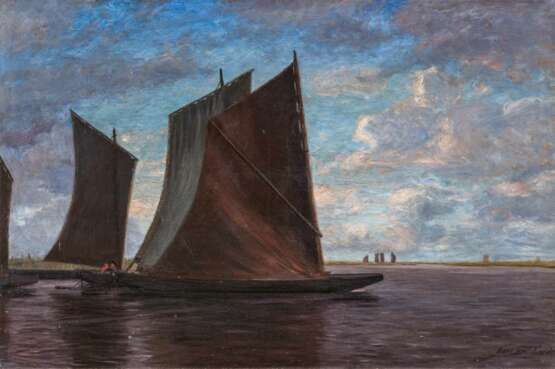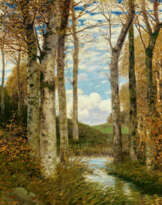ID 1208184
Lot 1201 | Hans am Ende. Segelfahrt
Valeur estimée
€ 15 000 – 20 000
Title: "Segelfahrt".
Peat barges in the Teufelsmoor.
Date: 1899.
Technique: Oil on canvas.
Measurement: 70 x 106cm.
Notation: Signed lower right: "Hans am Ende".
Frame: Framed.
Exhibition:
Rilke. Worpswede - Eine Ausstellung als Phantasie über ein Buch. Exhib. Kunsthalle Bremen 29.06. - 24.08.2003.
Literature:
Rainer Maria Rilke: Worpswede. Fritz Mackensen, Otto Modersohn, Firtz Overbeck, Hans am Ende, Heinrich Vogeler, Bielefeld 1903, p. 96, ill. 16.
Provenance:
Private ownerhisp, Germany.
A major trend in the last decades of the nineteenth century was the call to "Raus auf's Land" ("Out to the countryside"), away from the increasingly large and chaotic cities and into the peace and seclusion of rural life. What later manifested itself architecturally in the garden cities were, on the creative level of the painters, various artists' colonies that emerged early in the 1890s. In addition to the longing for a different, original life, they also satisfied a pronounced interest in outdoor painting and light. The great role models here were of course the French plein air painters, who were the first to leave their studios and gather in Barbizon.
From 1889, three young student painters came together in Worpswede, north of Bremen, where they worked on the proactive initiative of Fritz Mackensen and whose colony became one of the most famous in Germany. The other two founding members were Otto Modersohn and Hans am Ende, shown here, who were enthusiastic about life and the landscape around the "Teufelsmoor", the expansive views and the clear light. In 1900, the poet Rainer Maria Rilke also joined the artists, who portrayed the artists and their colony in a monograph in 1903.
In this description of the Worpswede colony and its most important protagonists, the two works presented here are illustrated. In the late 1890s, the artist dedicated an entire complex of works to the motifs of the peat barges in the Teufelsmoor, which are shown under lot 1201. In these works, the various aspects of the painting of the colony and the period come together again: a high horizon, together with the deep water, gives the depiction an expanse that provides space for the play of the clouds. This liveliness in the sky contrasts with the depth of the water and the dark sails. The painting also tells of everyday working life on the moor and the "real" life that can still be found in the countryside.
The work on offer as lot 1200, which at over two metres is very expansive, was created a few years later. The significantly stronger colour palette is typical of this period. In this, he is somewhat in line with his fellow painters, who were already working with bright colours earlier. Altogether brighter and more summery than the boats in the moor, a spatial expanse with a deep sky and widely staggered clouds dominates and determines the painting.
As with so many artists of his generation, the First World War brought Hans am Ende's work to an abrupt end. He made a few more sketches after 1914, but succumbed to his war wounds in a military hospital in 1918. As a founding member, he had a decisive influence on the Worpswede School of Painting, but always remained in the shadow of Overbeck and Modersohn. His works are characterised by a calm and unagitated mood that harmoniously combines idyll and pathos.
| Artiste: | Hans am Ende (1864 - 1918) |
|---|---|
| Technique appliquée: | Huile |
| Catégorie maison de vente aux enchères: | Peinture 19ème siècle |
| Artiste: | Hans am Ende (1864 - 1918) |
|---|---|
| Technique appliquée: | Huile |
| Catégorie maison de vente aux enchères: | Peinture 19ème siècle |
| Adresse de l'enchère |
VAN HAM Kunstauktionen GmbH Hitzelerstr. 2 50968 Köln Allemagne | ||||||||||||||
|---|---|---|---|---|---|---|---|---|---|---|---|---|---|---|---|
| Aperçu | |||||||||||||||
| Téléphone | +49 221 92586215 | ||||||||||||||
| Fax | +49 221 92 58 62 4 | ||||||||||||||
| Commission | 32% | ||||||||||||||
| Conditions d'utilisation | Conditions d'utilisation | ||||||||||||||
| Heures d'ouverture | Heures d'ouverture
|














